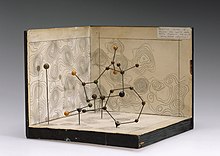Dorothy Crowfoot Hodgkin
Dorothy Crowfoot Hodgkin OM , née Dorothy Mary Crowfoot (born May 12, 1910 in Cairo , † July 29, 1994 in Shipston-on-Stour , England ) was a British biochemist . For her analysis of the structure of vitamin B12 she received the Nobel Prize in Chemistry in 1964 . In 1987 she was awarded the International Lenin Peace Prize.
Life
Dorothy Crowfoot Hodgkin was the eldest of four daughters of an English colonial official in Cairo. The parents, John Winter Crowfoot (1873-1959) and Grace Mary Hood (1877-1957), traveled extensively and therefore raised their children with relatives in England. Even as a teenager, Dorothy Crowfoot was fascinated by crystals and chemical structures. When she read Parson's “Fundamentals of Chemistry” at the age of 16, she decided to study chemistry .
From 1928 to 1932 she studied chemistry and physics at Somerville College , Oxford , where she spent her fourth year studying crystallography , before going to Cambridge to study sterols under the direction of John Desmond Bernal . She was entranced by the "elegance" of the then new X-ray structure analysis and, with this method, took for the first time diffraction images of many biologically relevant molecules, including pepsin (1934) and cholesterol (1941). Later she also solved the structures of cholesterol (1945), penicillin (1945, published 1949), vitamin B12 (1955) and insulin (1969).
In 1932 Dorothy Crowfoot returned to Oxford as a teacher. That same year she began chemical analysis of insulin , an analysis that would take 35 years to uncover the full structure of this substance.
In 1937 she married the political scientist Thomas Lionel Hodgkin, with whom she had three children, Luke (1938), Elizabeth (1941) and Toby (1946). Shortly after the birth of her first child, she became seriously ill with rheumatoid arthritis , but this did not stop her from doing her research. In 1947 she became the third woman to join the exclusive Royal Society . In 1958 she was elected to the American Academy of Arts and Sciences , in 1970 to the Royal Society of Edinburgh and in 1971 to the National Academy of Sciences . From 1962 Dorothy Hodgkin was a member of the Pugwash Conference and actively campaigned for the understanding of scientists from East and West.

In 1964 she received the Nobel Prize in Chemistry . Dorothy Crowfoot Hodgkin was the third woman after Marie Curie (1911) and her daughter Irène Joliot-Curie (1935) to receive this high honor. In 1965 she was the second woman - after Florence Nightingale - to be awarded the Order of Merit by Queen Elizabeth II . She was awarded the Austrian Decoration of Honor for Science and Art by the Republic of Austria . In addition, she was elected a member of the German Academy of Sciences Leopoldina - National Academy of Sciences . In 1970 she became Chancellor of the University of Bristol . The American Diabetes Association bestowed the Banting Medal on her, her highest honor in 1972 . She also received the Copley Medal in 1976 , an award from the Royal Society.
Margaret Thatcher , who wrote her thesis in chemistry with her, was one of her students at Oxford in 1946/47 .
Publications
- The X-ray structural analysis of some biochemically interesting molecules (= Working Group for Research of the State of North Rhine-Westphalia , Volume 159). VS Verlag für Sozialwissenschaften, Wiesbaden 1966, new edition ISBN 978-3-663-01037-1
literature
- Georgina Ferry: Dorothy Hodgkin: A Life. Granta, London 1998, ISBN 1-86207-167-5 .
- Jürgen Neffe : At some point I developed a very strong will. In: Charlotte Kerner : Not just Madame Curie. Women who got the Nobel Prize. Beltz and Gelberg, Weinheim / Basel 1999, ISBN 3-407-80862-3 ( book for young people ).
- Dorothy Hodgkin , in: Internationales Biographisches Archiv 37/1994 from September 5, 1994, in the Munzinger Archive ( beginning of article freely available)
- Svetlana Bandoim: Gender Bias in Science, an Analysis of the Careers of Kathleen Lonsdale , Dorothy Hodgkin, and Rosalind Franklin , Indianapolis, IN 2006, OCLC 75182013 (Dissertation (Thesis (BS) Summa Cum Laude) Butler University Indianapolis, 2006, 170 pages ( English )).
Web links
- Literature by and about Dorothy Crowfoot Hodgkin in the catalog of the German National Library
- Information from the Nobel Foundation on the 1964 award to Dorothy Mary Hodgkin
- Dorothy Crowfoot Hodgkin. In: FemBio. Women's biography research (with references and citations).
- Biography Contributions of 20th Century Women to Physics (CWP), (English)
- Guy Dodson: Biografical Memoirs Dorothy Mary Crowfoot Hodgkin Full biography of the Royal Society (PDF)
- Georgina Ferry: The making of an exceptional scientist In: Nature No. 464, April 2010 (English)
- Robert Lucas : Crystals and Children The Time No. 51, December 18, 1964
- Paintings by Dorothy Hodgkin in the National Portrait Gallery collection
Individual evidence
- ↑ biographical data, publications and Academic pedigree of Dorothy Hodgkin in academictree.org, accessed on February 12 2018th
- ^ A b M. J. Adams, TL Blundell, EJ Dodson, GG Dodson, M. Vijayan, EN Baker, MM Harding, DC Hodgkin, B. Rimmer, S. Sheat: Structure of Rhombohedral 2 Zinc Insulin Crystals. In: Nature. 224, 1969, pp. 491-495, doi: 10.1038 / 224491a0 .
- ^ Fellows Directory. Biographical Index: Former RSE Fellows 1783–2002. (PDF file) Royal Society of Edinburgh, accessed December 20, 2019 .
- ↑ Award Ceremony Speech (English)
- ^ A b Fortey, Jacqueline .: Great Scientists: [the book with poster!] Dorling Kindersley, Munich 2011, ISBN 978-3-8310-1884-0 .
| personal data | |
|---|---|
| SURNAME | Crowfoot Hodgkin, Dorothy |
| ALTERNATIVE NAMES | Crowfoot, Dorothy Mary (maiden name); Hodgkin, Dorothy |
| BRIEF DESCRIPTION | English biochemist, Nobel Prize winner |
| DATE OF BIRTH | May 12, 1910 |
| PLACE OF BIRTH | Cairo |
| DATE OF DEATH | July 29, 1994 |
| Place of death | Shipston-on-Stour , England |
